Wayne C. Allen's Blog, page 12
October 12, 2022
Mind Cobwebs
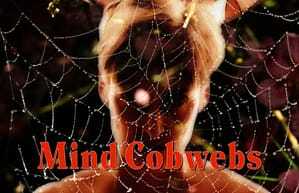
Mind Cobwebs — We’ve been conditioned by our families and tribes to ‘fit in.’ Making positive change is therefore difficult…

Want to learn more about living a full and meaningful life?
Want to have the best relationship ever?
Check out my books
The Mind’s CobwebsWe’ve been conditioned by our families and tribes to ‘fit in.’ Making positive change is therefore difficult, as many changes go against our ‘tribal’ rules. We explore how we set our values, and how to begin the process of questioning everything.
Patterns of Development — dealing with the mind’s cobwebsLet’s look at emptying the mind. But before we can explore a western take on the eastern idea of emptiness and how to use mindfulness, I want to talk about how fear and anger contribute to blocked or stunted growth.
There are a couple of human development models that I agree with. In this article, I want to discuss three. Next article, as we explore Mindfulness, I’ll pull it all together.
Maslow, Myss, and PeckSounds a little like a law firm, right? Some years ago, I created to following chart:
LocationMaslowMyssCrown Chakra, # 7Top of HeadTranscendence —helping others to actualizeSelf Knowing
wisdom, knowledge,
consciousnessBrow Chakra, # 6Bridge of Nose,
upper brow,
sinusesSelf-actualization
personal growth, self fulfillmentSelf Perception
psychic perception,
accurate interpretation
clear seeingThroat Chakra, # 5Throat, neck
occipitals,
jaw, lower face Aesthetic Needs
beauty, balance, form,
expression of true selfSelf Expression
Clear communication,
creativity, resonanceHeart Chakra, # 4Heart,
upper chest,
upper back“Purpose” Needs
self-knowledge, self-awareness,
meaningSelf Acceptance
Balance, compassion,
healthy relationshipsSolar Plexus Chakra, # 3Solar Plexus,
upper belly, mid-back
to pelvisEsteem Needs
achievement, status,
responsibility, reputationSelf Definition
Vitality, spontaneity,
strength of will, purpose,
self-esteemBelly Chakra, # 2Belly from navel down,
sacrum, pelvisBelongingness and Love Needs
family, affection, sexuality,
relationships, work group, etc.Self Gratification
Fluidity, pleasure,
healthy sexuality,
feelingsRoot Chakra, # 1Tailbone
perineum, legs,
sciatic pocketsBiological, Psychological and
Safety Needs
basic life needs, survival instinctSelf Preservation
Stability, grounding,
physical health,
prosperity, trust
Now, in a sense, the chart ought to be the other way around, as we move ‘up’ from ground to ‘heaven,’ and of course that’s how it looks in Maslow’s hierarchy.
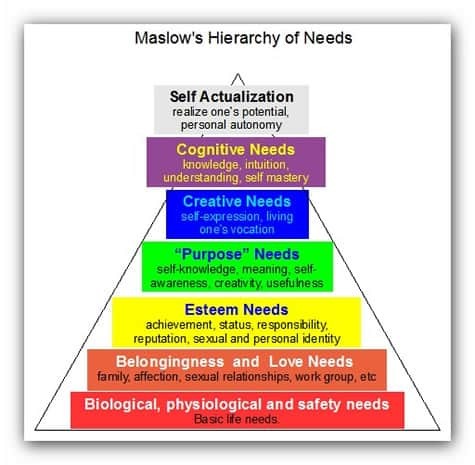
In both Maslow’s hierarchy and in Chakra Theory, we begin at the lowest level and develop (or not!) from there.
Why Most are Stuck at Level ThreeThe first three levels are physical, and are each about safety, belongingness, and escaping abandonment. Infants learn from the start to do what is necessary to keep the food flowing and the physical contact coming. Most people are highly ‘physical reality based,’ in that they fear actual, physical loss and/or abandonment.
A perfect illustration of this is how quickly people will abandon their ‘selves’ when someone threatens to leave them. Or they might think they are going to be fired. Principles fly out the window as the person seeks to save the relationship.
We learned to do this as children—staying a member in good standing of the tribe seemed to be ‘life and death.’
The Flavours of FearThe two main flavours of fear are ‘fear of loss’ and ‘fear of change.’ Abandonment, for example, could fit into either category. Now this might be obvious but think about advertising. Virtually all advertising targets one or the other of these fears. We’re conditioned to use the same products and the same methods for gaining safety and security. When in doubt, buy something!
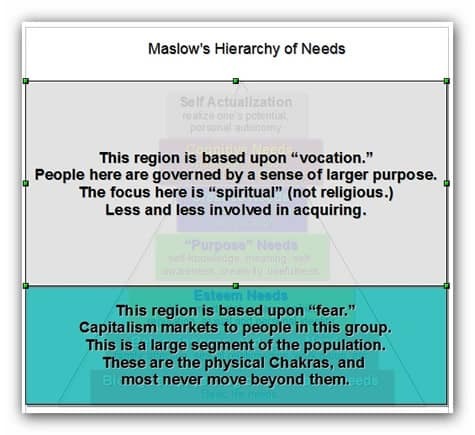 The Marketing of Fear and Lack
The Marketing of Fear and LackMarketing is directed at the largest demographic and caters to what “moves” them. We are thus bombarded with lack, loss, and fear-based ads, movies, TV shows, etc. We are told that if only we will buy in to the western consumerist lifestyle, we will have it all. We will be safe, popular, and smell nice.
Yet, it just doesn’t seem to work out.
The ‘vocational’ demographic, above, starts at the transition point between ‘physical’ and ‘spiritual’—and it’s simply a change of focus, orientation and direction.
Now, knowing this and doing something about it are two different things. I’ll soon spend some time looking at Buddhist concepts for dealing with the fear messages that occupy our minds at all hours of the day. For now, I just want you to “get” how they are implanted.
M. Scot Peck and the Stages of FaithPeck, best known for his amazing book, The Road Less Traveled, proposed four faith or development stages in his later work, The Different Drum.
Here they are:
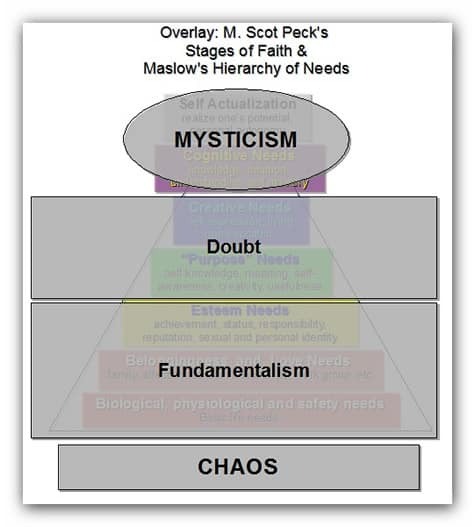
Peck said that everything follows these stages—physical, psychological, mental, and spiritual development.
He suggested that chaos is so unstructured that it breeds an intense desire for order and rules, and fundamentalism is the perfect “cure” for this. There are always people around that want to tell others how to live, after all.
For most people, fitting in and following the rules is all they want. Anything else is just too scary. Therefore, their effort is put into buying a house, having kids, getting raises and moving up the ladder at work. At the end of their working lives, most are exactly as Thoreau described: living lives of quiet desperation.
The stage beyond fundamentalism is doubt. This is the stage of questioning our beliefs, norms, goals, and directions. It’s the stage of moving from home, moving out of town, doing something different and challenging everything. Many people get just a taste of this in College or University, before they settle back into Fundamentalism, sell out, and buy the Beemer.
Doubt is the Exciting StageDoubt leads to questioning and mistrust—just the opposite of what society wants of good, loyal sheep.
Doubt that is informed and guided by mysticism does not seek to change the system. It seeks to redirect the attention of the individual to the only thing anyone can do anything about—him or herself.
Gandhi, for example, did not change England or India. He changed himself. He sat, he spun yarn, and he talked and he walked. He said, “You must be the change you want to see in the world.” and “Always aim at complete harmony of thought and word and deed. Always aim at purifying your thoughts and everything will be well.”
I suspect you’ve read this far because you are sick and tired of being bored, confused, angry, and turned off. In the end, there is only one way out, and it is the path of doubt leading to a change of heart, mind and direction. Our next articles will address these changes.
Facebook TwitterOctober 5, 2022
Bodywork
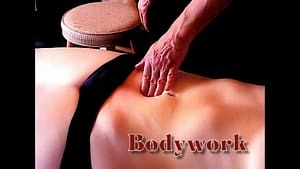
Bodywork is all about disentangling yourself from your wacky thoughts. We all have them. Blaming, chiding, criticizing, ornery thoughts.
Back when there was a phoenixcentre.com site, there was a highly popular Bodywork section. I’ve been working on turning the infornation into a book / e‑book. So, let me know–good idea? You interested?
The word of the yearSeveral years ago, I picked my “word for 2010,” which was “unbinding.” I decided on “unbinding” as an expression of nirvana - a state of being that is devoid of clinging, perturbations, and knottiness.
Unbinding comes from one definition of this hard-to-define word. (see wikipedia)Nir, (means “knot”) + va-na, (means “weaving”,) = “freedom from the knot of the distressful thread of karma.”
Unbinding. Unknotting. Untangling.So, the wise soul asks, “Unbound from what?”
Unbinding oneself from the allure of mind trips by joining the mind with the body in the here and now.
In the last article I mentioned that true vulnerability is a byproduct of escaping from the trap of endless mental games and descriptions, into the realm of action. And this seems to me to be the ultimate unbinding.
Oh. By the bye, notice that the word is unbinding, not unbound. This is a process. We learn how to unbind ourselves, and then continue to do so, until we die. It’s not one time, game over.
This is not a quick fix — quick fixes aren’t, and don’t!
Most people I know live in their heads, and have only a nodding (couldn’t resist…) acquaintance with their bodies. And in this article, I don’t even really want to talk about doing bodywork.
I want to talk about how sad it is when one is caught in one’s stories.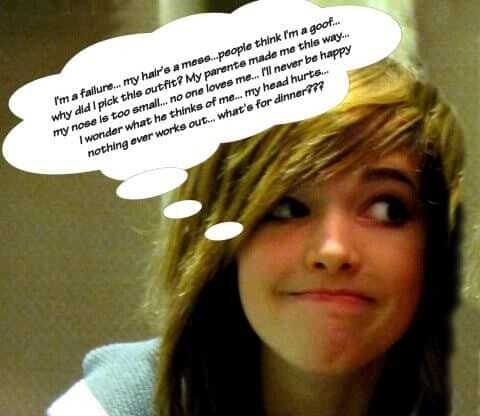
Oh, the twists and turns a tangled mind is capable of. It’s like a rat’s nest up there. Some people alternately love and hate their spouse. Back and forth, back and forth.
“She” says she wants communication, and all she does is judge. She says she wants fun, and all she does is blame.
“He” gets tired and pushes back, and she gets harsher.
He pulls in and acquiesces, and she decides to stay, as she’s convinced he’s finally trainable.
And nothing changes, as this loop is ingrained in both of them, and they “enjoy” the drama.
Others get caught in a “I’m a failure,” or “I’m not good enough” loop. Others, in an “I’ll never have a successful (relationship, career, family. etc.)” loop. And the odd thing? All that’s happening is that they are on a hunt.
For what, you ask? More “evidence” to support their preconceived notions.Makes you wonder: why collect evidence to support what you say you don’t want? Answer: because they DO, at some level, want to confirm their tale of woe. Much better than the risk and insecurity of striking off on an uncharted walk.
And there lies the rub.
Despite the obviousness of this, let me state:
Thinking about doing things differently is being caught - entangled, bound, because thought — thinking, pondering, reflecting, all change nothing.
Griping, complaining, demanding rescue, demanding that the world change — changes nothing.
Doing something different? That changes things. It’s the only thing that does.
Change comes at a price, and the price is actually doing something. In most cases, it’s doing what you say you’ll do.
If you say you are going to communicate using a model, you do so.If you say you are going to start a project, you start it.If you say you’re going to treat your grown kids as adults, you do it.No griping, no whining about how hard change is. No blaming your parents for inadequate training in getting a life.
Unbinding is stopping doing what does not work, while doing what does.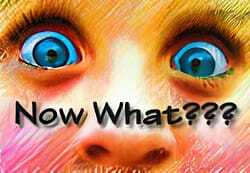
Unbinding is disentangling yourself from your wacky thoughts. We all have them. Blaming, chiding, criticizing, ornery thoughts. On and on, like a broken record. They mean nothing, and are just chatter, unless you choose to make them the centerpiece in a meaningless life. Then, they take on a life of their own.
The next time you feel bound, tight, caught, have a breath. Move your attention to the tightness, hotness, coldness, dryness, or wetness in your body. Ask yourself, “What is this? What does my body want?”
Mostly, if you listen, you’ll hear, “Do something! Move me, shake me, use me!” Those aches and pains have been caused by you, as you forced your body into submission and surrender, and yet on it fights, sending you messages, trying to get your attention, cajoling you to act differently.
Go out of your mind, and come to your senses.
Fritz Perls
Unwrap their arms from your chest, unlock your legs, and open yourself to the world. Become free of boundedness, and open to possibilities. From this stance of vulnerability, it is possible, very possible, to take a tentative step or two into another reality. But only if you unbind yourself, and then take a step.
What story are you using to stay bound? What would it be like to unbind yourself? What fear-based story do you tell to stay stuck? What would it be like to tell yourself a more interesting story?
What would it be like, to let your body work?
Facebook TwitterSeptember 28, 2022
Vulnerability — 5 things
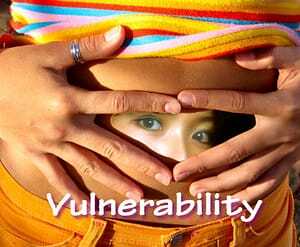
Especially in the West, vulnerability is considered a weakness. This is taught to us by our parents and tribes, who are, of course, concerned for our safety. However, this fear of vulnerability is ingrained at a deep level, to our detriment, once we become adults. (This is one reason most adults aren’t!)
Back when there was a phoenixcentre.com site, there was a highly popular Bodywork section. I’ve been working on turning the information into a book / e‑book. So, let me know–good idea? You interested?
1. The courage of being vulnerable -Consider: most people are looking for intimacy — and by that I mean, simply, “to be known.” If I hide, maybe no one
If I hide, maybe no onewill notice me!
But they fear letting others in””or at least want their safety 100% assured, before they will let down their guard. This is so because of the ingrained and mistaken belief that one can be hurt through the betrayal of another.
No one hurts us but ourselvesSure, people betray us. People walk away, leave us, judge and criticize us. This is a part of life. And yes, there is pain. But the pain is self-inflicted, as we tell ourselves awful stories.
The norm is to roll into a tight ball and to refuse to risk again.
An alternative is to open up and risk it all, time and time again.
Sure, such an action means that something might happen, and you might just choose to again pick up the knife of self-flagellation, and go at yourself again.
The alternative to vulnerability is not courage, but isolation, woundedness.”From a bodywork perspective, the sign of isolation and fear is “legs tightly closed, arms crossed over the heart, head down.” Like the picture, above.
The cure is opening up.Which takes courage. Not because there is a big bad boogeyman out there, waiting to pounce. It’s all about you, and in this case, it’s all about facing up to how icolating fear can be.
Once I truly and deeply understand that all psychic pain is self-inflicted (All of it. 100% Everything going on inside of you is you, etc.) I can be gentle and kind with myself. I can uncross my arms, open my legs, plant my feet firmly on the ground, and look up.
And I can speak my deepest, most intimate truth.
2. Being vulnerable means speaking your truthNot the truth. Not other people’s truth. Not the truth of “Everybody knows.” The truth that comes from
“Here is what is so for me, and here is what I do with this truth.”
Mostly, we try to defend our truth, and in this way maintain both control and a (mistaken) sense of invulnerability.
Speaking your truth is an interesting concept. Most take it to mean, “Endlessly regurgitating the same story, so that others will agree with me.” For me, it begs the question, “What do you want?” Which tends to be the question I ask when someone starts into this pattern.
Speaking your truth is not about getting others on board with your stuckness. It’s opening yourself to what lies directly beneath the stories.
3. Vulnerability is here and nowWhich explains why it’s not about stories. Stories, at best, serve as a framework for true vulnerability.
Vulnerability is about letting out what is going on for you, right now, with no explanations. This is me, right now. And part of “me, right now,” are the emotions that are happening inside. Not descriptions of the emotions, not blaming someone for the emotions, but rather the emotions themselves.
Once you are able to both see this and express it, you’ll also notice that emotions are fleeting. I can be sad, then bored, then weepy, then laugh-filled, then have the feeling of “nothing much.” But only if I do not cling to the “endless reality” of my story, a.k.a. thinking too much.
4. Vulnerability is unguardedUnguarding yourself means being willing to both own and share your in-the-moment reality, without much (or any) filtering. Again, this flies in the face of our conditioning.
Our tribes shut this sort of sharing down. Parents who fear intimacy and emotions tend to either distract (“You have a great life! What do you have to be sad about?”) or threaten, (“I’ll give you something to be sad about!”) to get us to stop emoting.
How much better to teach our children to responsibly express and process their emotions!Being unguarded is not about being unhinged, although that’s OK too.
The point of letting go is to clear the decks so that you can begin to shift what is not working. Letting go gives us an opportunity to see how we are structuring our stories to stay stuck, and to commit to, and actually do something new and refreshing. It’s not meant as an exercise in self aggrandizement, and emphatically is not a game to stay stuck, while pretending to “get it.”
Unguarded means loosening the filters, and expressing yourself as you are, with focus and clarity.
5. Vulnerability is body-workAs compared to mind work. You can’t be vulnerable if all you do is describe what you are feeling, thinking, and wanting. This is where story telling blossoms, and “Everyone knows…” rears its ugly head.
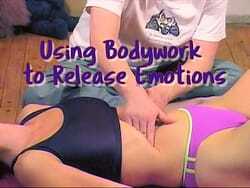 Yes!!! Push there!!!
Yes!!! Push there!!!While describing is certainly a step in an interesting direction (as opposed to stuffing it all,) it’s only quasi-vulnerability.
Many say, “Something comes up, I start to discuss it, get upset, and immediately leave the room, so that I can go ‘figure it out.’ Once I’ve calmed down, I come back and tell my partner what I’ve discovered.”
Yikes.
This is running away, actually, couched in the rubric of dialog.
This is feeling what’s going on in your body, freaking out, and rapidly escaping to the head.We’d suggest staying in your body, and letting your partner participate in the process, without running away. If you do so, you will likely discover an interesting thing.
There are points in your body just screaming for a bit of pressure to be applied. And when pressure is applied, all kinds of sounds and emotions emerge, then fade, and whatever the drama was, fades with them.
Facebook TwitterSeptember 19, 2022
Crowning Glory — The Body Speaks
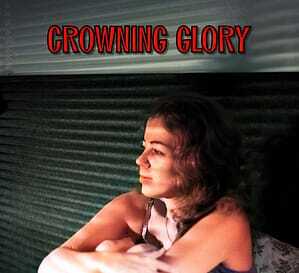
Crowning Glory — our heads are a blessing and a curse. If we buy into our stories, we live in our heads, miserable. Or, we can continually choose to see our games while not biting.

Want to learn more about living a full and meaningful life?
Want to have the best relationship ever?
Check out my books
 This is the last article in this Series — The Head Zone — “Crowning Glory”
This is the last article in this Series — The Head Zone — “Crowning Glory”The concepts we’ve been looking at are superficially easy, and there lot of people get all of this stuff, at least intellectually. What there is a decided lack of is actually living any of it.
Most people, for example, “get” the idea of no self. They just refuse to experience it. “I could have sworn me
“I could have sworn mewas me!”
The theory of “self-less-ness” makes sense, but it’s really hard to give up the idea of a permanent self, past and future, and the ego’s view of being really, really important.
Simple Zen guy that I am, I’m only curious about how people (including me!) are actually living their lives. If they are creating misery for themselves, (and no doubt blaming all and sundry — externals — for their pain) I remain unconvinced that their“understanding” is doing them much good.
Similarly, many people I know are Spiritual junkies.
Which is sort of where our topic is heading.In Chinese medicine the crown of the head is seen as an entry point for chi. It’s often pictured like this.
 Holy Streaming Chi,
Holy Streaming Chi, Batman!
The image shows a funnel of chi — energy — the bottom of which is firmly screwed into the head. Through this funnel, the person receives “the bountiful blessings of heaven.”
Here’s where this goes off the rails.
Life is, indeed, exactly like this. In case you haven’t noticed: if you’re not dead, the Cosmos is providing everything you need. As a matter of fact, it’s even providing stuff, experiences, that you either don’t know you need, or wish you didn’t need.
Here’s the off the rails part.Most people think that the Cosmos operates on a reward / punishment system. Thus, “If I’m a good little Doobie, ‘somebody up there’ is going to shower down goodness upon my little head. And all those people I don’t like? Well, I’ll just pray that they get straightened out, preferably by being tortured in ways that I think appropriate.”
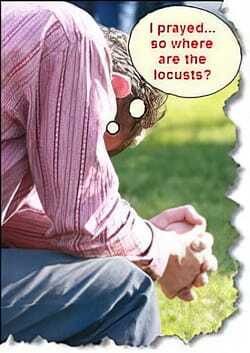
And often, they’re quite pissed off when the bad thing they want to happen to the other person doesn’t happen. Hallelujah.
Speaking of prayer, most people do this thing by griping and complaining, and then telling “God” how to solve the problem. Then they sit there, tapping their little feetsies, waiting for God to go along with their little plan.
There is a line in the Bible that goes something like,
“The rain falls on the just and the unjust alike.”
Fake-Spiritual people hate this line, as it just doesn’t seem fair.
In the Zen world, it’s impossible to tell exactly what ‘just’ and ‘unjust’ looks like, apart from each person’s skewed personal preference.
This goes right back to what we’ve been talking about for the past many weeks. Our existence is totally, 100%, subjective.
It’s all about the stories we tell ourselves.In the last article, I made an attempt to contrast Seeing with thinking, or better put, storytelling. Seeing is all about simple perception of the ongoing nature of life — of the ongoing nature of the universe.
As soon as you start thinking about it, and analyzing it, you’ve left the flow of the moment-by-moment experience and ended up back in your head, where nothing is real, and distractions abound.Truly Seeing is, oddly, nothing more than living moment-by-moment in the here and now.
Which is amazingly hard to do.Which is something that needs constant reinforcement.Which has absolutely nothing to do with anyone else, orwith others giving you permission to do it.It’s like meditation. You either do it, or you don’t. Blaming external circumstances, who you are living with, or whether you feel like it is simply going back into your head and making another excuse.Back to the funnel photo. Just what is all that stuff streaming into our heads?I think of it it as both moment-by-moment experience, and the provision of exactly what we need, without our earning or deserving any of it.
I just finished a book called, “Buddhism is Not What You Think,” by Steve Hagen. Here are a few quotes:
“Reality is always right here, right now. It’s just this …vibrant, immediate experience… Most of the time, however, we superimpose something onto what is immediate and Real. We project onto what we directly experience, and we extend that projection through time and space. Thus we create subjects and objects… The upshot is that we don’t engage the world as it actually is. Instead, we react to the world as we assume it to be — or, worse, as we think or wish it ought to be.”
p.204–05
The games our mind plays with us go on until we die.
Nattering, scattering, and storytelling is what our minds are all about.Our job, decidedly, is NOT to fight against our mind. Our goal is to sidestep our mind by “simply noticing.” Quoting Hagen again,
And that stream of stuff, flowing into our heads? This flow is all there is.“The awakened see Reality as it is. They see that enlightenment is nothing more than not being deceived by the conceptual world each of us creates… The most basic split, of course, is “here I am” and “out there is everything else.” … The enlightened person isn’t taken in by such conceptual dualities. Still, it isn’t that the illusion goes away. The illusion still appears, but it’s seen for what it is — an illusion. And this seeing is utterly liberating.”
p. 206

I once read somewhere that we are, and everything we perceive is, sort of like a bubble in a rushing stream. The bubble appears both “real,” and “separate” from the water.
The bubble is actually “water-ness” that seems to appear on the surface of the water.
It appears, goes with the flow, and then pops, and vanishes.
At no time however, can we think of the bubble as being separate from the stream. Other than in our twisty — turny little minds.
To quote Hagen:
Now, back to the dilemma.“It’s not that the universe is made up of innumerable objects in flux. There’s only flux. Nothing is (or can be) riding along in the flux, like a cork in a stream; nothing actually arises or passes away. There’s only stream.”
p. 220
Many people equate being Spiritual with being special. Darbella and I were considering, briefly, going off to Ohio to meditate. I was really impressed that the Zen Center said that no one meditating there was to wear robes, or use their “Dharma name.” (A Dharma name is the name you are given when taking Buddhist precepts.) They said that everyone was the same at their Center — and I just amused myself, as it’s also so that we are all the same at our center (inside of us.)
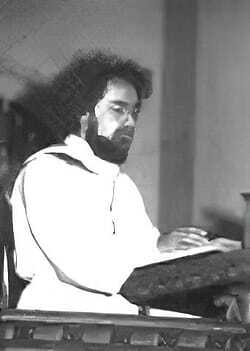 Lookin’ mighty fine!
Lookin’ mighty fine!Anyway, I’ve always been a guy who likes “dress up.” Back when I was in the Ministry, I had all the outfits. It was entirely possible that if I put on the full regalia, the outfit had cost me $1000.
There were points when my hair and beard resembled what I thought of and jokingly called my Rasputin look.
Therefore, part of me would love to hop into a set of Zen robes — many times, I wear Chinese style martial arts clothing when I meditate. I examine my motivation relentlessly — and believe I wear them because they’re comfortable and have pockets.
But I recognize I have attraction for costumes. It reminds me of the old doggerel:
I see by your outfit that you are a cowboy.
I see by your outfit that you’re a cowboy too.
We see by our outfits that we are both Cowboys.
If you buy an outfit you can be a cowboy too.
Special, special, special.
Which makes it hard to simply be the flow. Not of the flow, not in the flow, not the special, special part of the flow — but the flow itself.
And the joke is, whether you get this or not, whether you believe this or not, whether you hate this or not, this is what there is — this is all there is — the flow.
Getting the joke about a separate identity (while still having one, we’re not nuts here) means that you are freed up — liberated — and are therefore capable of acting and being as you act and be, moment- by-moment. You see the stream, the flow, and you recognize it for what it is — that which empowers and enlivens us all. It’s not the possession of the special, it’s not a tool to be used to gain something.
It and you just are.Back to sitting. Literally and figuratively, he says with a smile.
Many people show up to learn meditation, and they have a goal in mind. They want to relax, they want to manage their pain, they want to find themselves. They may even think that meditation will lead to enlightenment.
While it is possible to achieve such practical goals, and indeed, as you meditate, such things can and do happen — the real purpose of meditation is to see the flow of life, and the endless silliness of the thoughts we concoct in our heads.
Meditation does not stop the thoughts — it can’t — nothing can.Our egoic thoughts, our desperate selfishness, our burning desire to be different, is our constant companion. Meditation helps us to see what we do up there in our little heads, and to just let it be.
Thoughts come, thoughts go, and are meaningless yet tempting.We can attach to them and follow them, or we can laugh and let them go. If we do the latter, we find ourselves “just sitting” in pure awareness.
If you read back over the articles in this series, you’ll see themes emerging.The most obvious is the one about the mind, and the mind’s games.
Yet, if you look, you’ll see that none of the Zones have anything to do with thinking, analyzing, or categorizing. Rather, from tie to head, it’s all about simple experience.
That’s the joke behind the line, “If you meet the Buddha on the road, kill him.” You can’t see the Buddha outside of yourself, because there is nothing outside of yourself, and if you’re seeing him out there somewhere, you’re missing the point.Now, all good Westerners know, (have been browbeaten into believing,) that we are all born in sin and need a Savior. Good luck with that. Our crowning glory reminds us that salvation, like everything else, is an inside job. That you continually forget this, and look outside for salvation, is not the fault of the Cosmos.
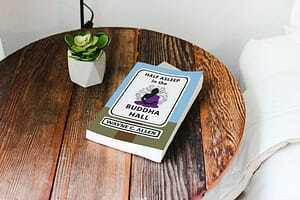
Looking for more on this topic? Check out my book, Half Asleep in the Buddha Hall.
Facebook TwitterSeptember 12, 2022
Insight — The Body Speaks
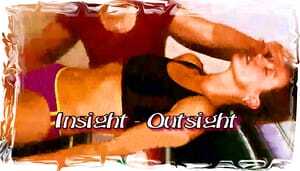 The Zen of Insight
The Zen of InsightInsight: Our focus pulls inward, and then, as predictably as the sunrise, we’re pulled into our minds, there to tell ourselves stories and distract ourselves outward. We bring ourselves back by dedicating ourselves to insight.
Today, we turn to the Brow — The Zone for the Zen of Insight This Zone has several names — the Third Eye, the Seat of InsightTo begin, notice that word — in-sight.
This Zone has several names — the Third Eye, the Seat of InsightTo begin, notice that word — in-sight.
There’s a ton of confusion about this:
about how we see what we see,and what “what we see” means.I don’t think I’d be exaggerating saying that 100% or the issues in the world, and in us, come from missing the following point:
Your rules, the ways in which you structure your reality, are implanted by your culture, and what’s hammered into you head is that these rules are right.
Even if you stomp your little feet and do things another way, as soon as you think your other way is “right,” you’re back in the societal game of, “My view is right, yours is wrong, and I’m going to change you.”
In the Tao, form arose from formlessness, and this fits the Big Bang Theory. The universe was empty, and suddenly, it was everything.
Now, the thing I like about this is that everything that is, from stars and planets to microbes and you, are all made of the same stuff . Our atoms are the same as the atoms of, say, that mountain over there.The Universe does not care about you. The universe has “Kept on Truckin’ ” for billions of years, and will, likely, for billions more, and you are, both in time and in size, a micron of a micron in all of this.Sounds grim, right? Well, I think it’s actually liberating.
Our culture tells us we “should” strive to make a difference, be unique, and change the world. Now, on the surface, this sounds all noble and poetic.
The problem, however, is that such an approach often leads to “thinking you are entitled.”
The key is doing–going out and doing something. This is very Zen.The problem with “fix the world,” however, is this. It reinforces our erroneous belief that our problems, the solution, our salvation, etc. is “out there, somewhere.” We waste our lives on “out-sight,” frustrating ourselves when the “outer” refuses to yield to our specialness.
This approach misses the point. Out there is and always will be, out there.Nothing out there needs us the way we want to be needed. Indeed, out there exists without us. It just is.
Secondly, what is is not “real” until we apprehend it and label it.
Nothing exists until it enters us, and we label it.For example, bring your attention to the sounds around you. Did they exist before you heard them? Can you prove it? Of course you can’t, and this can be very, very scary. We think, “I just heard that fan motor, and it obviously was “there” before I heard it.” But, you see, there is no “there before you heard it” that you can prove existed, because it’s already in the past, which does not exist now, and cannot be proven.
We take it for granted that there is a past, but it’s just a social convenience. We tell stories of the past, and we all wink and pretend that they are true.
Here’s a hint: they’re not. They are made up, and so are you.Now, most people, reading this, want to fairly fly up into their heads, create a stunning argument for why Wayne is off his rocker, and maybe even stop reading further. But again, that would be you, up in your head, having an imaginary conversation with me, who has never even once visited your head.

Everything you think I’m saying in this article is you, in drag, playing me.
Zen insight is seeing that our minds are pre-programmed to invent the past and future, to label, judge, blame, and to create divisions.
The Tao tells us that from the “One” of existence comes the “Two” of duality (right/wrong, good/bad, attraction/repulsion, me/others) and the “Three” of the relational “interaction” that exists between the separate things.
It appears that there is me, you, and our interaction.Seems to be so, doesn’t it? Yet, if you can pull back a bit, insight will show you that there is nothing more than your judgements and division-making — your “role and rule making.”
In Zen, this understanding of Reality (capital R) is paramount for achieving Freedom (capital F). Freedom is freedom from our own mental processes.
Meditation serves the purpose of letting us see how pervasive our labelling and thinking is.We sit, and observe, and suddenly the background mental chatter is right there, as plain and obvious as can be.

It’s largely crap, and consists of half-formed stories that catch our attention. We get all intrigued, and push “PLAY” on the story machine that is our mind.
Except that we are the director, writer, and cinematographer, and all the work happens after we push the PLAY button.
We’re making it up as we go along.
It still isn’t real, as in True (capital T), but it’s ours, and we’ll defend this mental creation to our detriment, right up until we curl up our toes.
So, what’s the alternative, you ask?Waking up.
Seeing what we see as it is. Life continually provides raw data, and all of it is colourful and meaningless. If we can stop ourselves from making the leap into our heads, to categorize, label, and judge, we have the opportunity to just Be (capital B) with what is.
This changes everything.
Because beng awake means living the present experience, savouring the present moment, doing what is required in the present moment.
Here are some ways:
MeditateYup. Again. Sit down, stop whining, and observe the games your mind plays. It’s not called Monkey Mind for nothing.
Notice the mental gymnastics, the effort you put into distracting yourself from just sitting. Notice how badly you want to accomplish something — get enlightened, have peace, be different.
Notice how that is not working out.
Meditation brings us into the moment, and gives us the chance to simply Be. No goals, no things to accomplish. Just Sitting, Being, Breathing.
Open Your EyesSee with your “artist eyes.” We all have them. It’s about opening your senses to input, and holding your rush to interpret at bay. You do this by continually coming back to the object (sight, sound, feeling, etc.) at hand. Or eye. Or ear. Be present with the feeling.
Open your eyes and be present for your life, and your experiences.
Get the JokeThis follows the last one, in ways other than the sequence. The joke is, you’ve been so busy living in your head, (and by definition, “in your head” is either past or future) that you’ve missed your life!
You’ve been so busy with “the stories,” you’ve missed the Reality.
And then there’s the joke about your stories! They’re crap! Not True! Figments of your imagination! Moronic! Foolish! And, boy, do you love your stories!
In fact, you bend Reality, others, events, and history to fit your preconceived notions of who they are, how they are, and what they mean! And you’ve missed Reality. But boy, have those stories in your head been fun! Chargy! Dramatic. And boy, are you ever important, up there in your head.
And you can’t for the Life of you, figure out why everyone else doesn’t think you’re as magnificent as you think you are.
(Magnificent in either the “great” direction, or the “poor me, I’m such a victim” direction, as those are the movies that sell — both in the “real world,” and in your head.)
Get the joke, get over yourself, have a breath, and go back to step 2.
Refuse to ArgueMany people try to persuade me that I don’t know what I’m talking or writing about. I don’t care. This is not, for me, a debate.
I do not care if you approve, get it, or whatever. My choice is to write about this stuff, hopefully to twig your imagination, and to get you to look (see step 2) at what you are doing. I do not think I am right, and therefore that you “should” do as I do. I want you to do what you do, and to be clear that you are choosing. Not forced to. Not genetically predispositioned. Not the poor helpless victim bilge again. Choosing.Stop arguing, with anyone. What are you trying to prove? That you are right, of course. You have it all figured out.
Here’s a hint. If you had it all figured out, you wouldn’t need to argue, to convince others of your brilliance.
You’d just be present in your life, having your experiences, and you would know Reality and your place in it. You’d have nothing invested in others agreeing with you or changing for you.
And if perchance how you were living your life seemed, to others, to be worth emulating, you’d just smile and say, “Have fun!”
I do have a belief. If your life is working for you, it shows. You are content, and you do not complain nor judge. You just Live Life. If you think you know, and your life is a misery, hmm.
Have fun!Be with others, as they are.
This follows. Other is anything other than you. And you don’t really exist either, so other is also you.
Nope, not crazy. Let’s “do you” first. Sounds like fun, eh?
The only you the one who just read these words. And these words. When you pretend you are the person who existed in the past and is existing into the future, you are caught in the big lie. When you go into your head and invent yourself, ever again, you are picking and choosing a story out of your memories (which are notoriously faulty…) and likely making stuff up. And then, you want others to agree with your made-up story.
Or, let’s say you were victimized when young. Does that determine how you are right now? Of course not, unless you choose to view your life through that filter.
Same with others. You have an opinion about everyone, and they’re just stories. How they are right now, is how they are right now. Doesn’t mean anything, or better, they are only as you see them. If you want to demonize them, feel free. That’s just you, playing games again.
You could also be with the person as they are. If you are attracted, move close. If repelled, move away. If neutral, hang around and see what happens. Simple.
Facebook TwitterSeptember 5, 2022
Self-less Expression — The Body Speaks
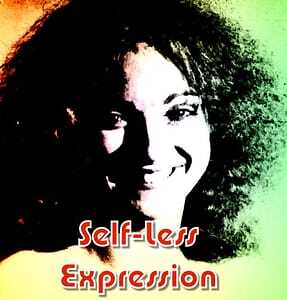
Self-less expression is all about speaking your truth without letting your ego get in the way. We find a way to “voice ourselves.”

Want to learn more about living a full and meaningful life?
Want to have the best relationship ever?
Check out my books

My first and most popular book, This Endless Moment. Learn to live a full and satisfying life.
Today, we turn to the Throat zone — the Zone of Self-less Expression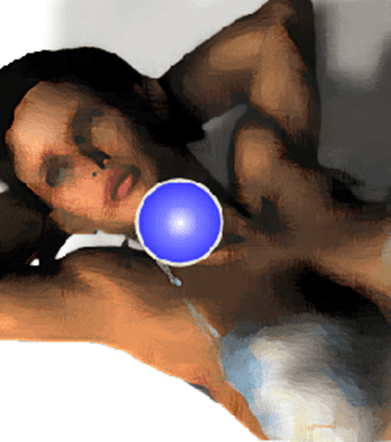

This zone, runs from below the eyes down to the tops of the shoulders, including the little pocket that you can feel if you push “down and in” in the hollow above each clavicle.
The zone includes
the back of the neck and the occipital indentsthe two points indicated below the eyes (the “anchor of the social mask,”) andthe semi-infamous jaw points.In other words, lots of picky little points, most of which hurt when you push on them.
This Zone is about expression. (Preferably self-less!)This zone is where you enact what you have learned about yourself.
The process of human development, at its best, (which happens for precious few people, because of the work involved…) is contained in Ken Wilber’s famous concept, “transcend and include.”
What this means is, at each step along the way, we have something to learn that we must also take with us.
To put it baldly, the goal is not to figure out we have a body, only to “give it up,” and become all spiritual. It’s about accepting ourselves exactly and precisely as we are.
And then, finding a way, or multiple ways, to be (to enact… to express) the totality of who we are.I’m always reading books by Osho. In his “The Book of Secrets,” Osho’s book on Tantra, he mentions that he read somewhere that Freud thought all people were neurotic–and were born that way. Osho disagreed.
Osho says that we are all born natural, and are turned neurotic by our upbringing. The neurosis comes as our cultures force us to split ourselves into pieces.
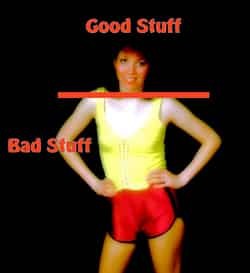 What do you mean
What do you mean you’re looking at my eyes!
Osho uses the example of parents getting their infants to stop crying. This is really the first split — splitting off the body (feelings) from the mind (thinking.)
What the child learns is that if she cries she creates a disturbance for others, and is “rejected.”
Now, clearly, the parent is disturbing himself — the child really has nothing to do with it.
I was speaking with a friend yesterday, and she mentioned that she had been babysitting a couple of girls. The girls fight a lot, and my friend described being torn between walking out of the room and stopping the fights.
Notice the judgment: fighting is ‘bad / a disturbance.” (Or better put, my friend disturbs herself when witnessing fighting.) So, she created two options for herself. Walking away, or stopping the fighting.
I suggested that she could create a third option, which is to sit there and simply witness the girls fighting, (while maintaining a “no hitting, no hurting” posture) until they finished.
If she tried this, and if she stayed fully aware, she’d notice how she is upsetting herself over her imaginings about how “bad” fighting is.
Her tendency, as it is with most of us, is to either
run away from things we bother ourselves over, ortry to get others to stop doing what we bother ourselves over.Being a simple Zen guy, it seems to me easier to stop bothering myself.Anyway, the first “split off” for most of us is how we split off from our body and emotions. Most people see themselves “catching their emotions from others,” rather than simply having them. “He makes me so angry” is how this worldview is stated.
The mature, adult view we are promoting is this: “I am making myself angry, and here is how I am going to choose to express it in a safe and elegant way.”
This approach is what begins the healing process — the rejoining of all of the parts of ourselves into a coherent whole.
Most people think of expression as endlessly flapping their lips and expecting the world to give a damn.“The mass of men lead lives of quiet desperation.”
Henry David Thoreau, “Walden”
The quiet desperation most people live in is the desperation of trying to bend others and the world to their will — and endlessly failing.
Or, trying to figure out what other people want, and endlessly giving it to them, in the vain hope that this will somehow make everyone happy, healthy, and disaster proof.
The alternative, the scary, scary alternative, is to, in the title of the old song, “Express Yourself.”Instead of tightening down and repressing yourself, you take the risk to open up and be fully human.
This is not a prescription to be yourself. Your “self” is what gets you into trouble in the first place.
Thus, self- less expressionAs hard as this is to accept, your “self” is a mental construct, and a series of habits. No matter what you believe, the only person you are is the person you are right now. And now. And now.
The only place you have ever been is here.
And at the same time, you’ve never been here before.
The key to this article, and perhaps the key to your entire existence is this:
This is it.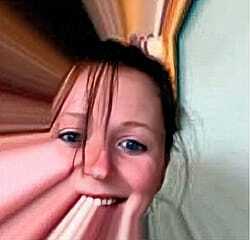
Think about it. How much time, money, and effort have you expended trying to have what is called a peak experience — a “once-in-a-lifetime,” earth and self shaking moment?
You might even remember, up there in your twisted little mind, a couple of events that you so classify. So, you try, and try, and try, and think, think, think, hoping for “the biggie,” the killer “once-in-a-lifetime event.
Well, the joke’s on you.
Every single moment of every single life is, and only is, and can only be, a once-in-a-lifetime experience.You’re endlessly living through, without noticing, what you think you’re waiting for!
Please, understand. This is not semantics. This is the way it is.
We waste our lives, our moment-by-moment moments, thinking about past moments, and dreaming about future moments.
“Yeah, but that moment was better than this moment, and the next moment will be better than the moment I had a moment ago. Don’t you know anything?”
And somehow, this idiocy never quite works out. (You think??)And have you noticed your mind’s habit, in the midst of a peak experience? You’re saying to yourself, “Boy, is this ever great! And the next time will be even better!” And boom, you’ve gone up into your head again.
The Expression zone calls us into being, just being.It calls me into knowing who I am, in this moment, experiencing my experiences. When thinking, say, “I am thinking,” or better, “Thinking.”I am tuned into my body, to its aches, to pain, to pleasure, to the joy of simply being alive. Moment by moment.If I notice that I am resisting acting, out of fear of getting it wrong, I recognize that not acting is acting. Rather than do nothing, I choose a path and take a step.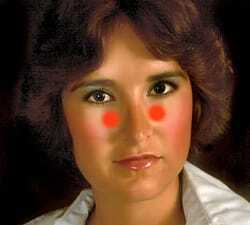
Locate these two points on your face.
They are called, poetically, the anchor points for the social mask.
This, from a Bodywork perspective, is where we anchor our act.
This is the pressure release point for all of the rules and roles society has stuffed down your throat, and which you so willingly swallowed.
It’s the home of labels — like father, mother, son, daughter, husband, wife, child, parent — each of which comes with a specific set of socially approved behaviors.
You may have strained against the tight bindings of these set behaviors, perhaps unconsciously.
But strain you must, because you never have been, you are not now, and never will be, a role.
So, spend a bit of time inserting your index fingers into these points; push down, and see what comes up.
During Bodywork, much time is spent in the Zone, and especially on the jaw points.It’s a tough area to work with, because it gets really sore, really quickly.
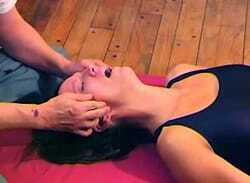
In both Bodywork and Breathwork, pressure is applied to the jaw points.
Most people have really tight jaws, as they spent their entire lives repressing the expression of their true natures.
We are all whole, healthy, alive–and we’ve been persuaded that sharing this is the dumbest thing we could do. So we clamp down On our jaws, and elsewhere,) tighten up, hurt ourselves, and find ourselves incapable of expressing the truth of ourselves.
So, thumbs on jaw points, y’all!
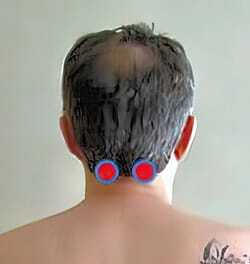
Many people, the day after a Bodywork session, report what they call a base of the skull headache. The occipital indents are another really sore place for people, and I think it’s the height of irony that those little dents are exactly and precisely thumb-shaped.
It’s almost as if we were designed to have someone shoving their thumbs into our occipital indents.
If those areas are tight and sore, I suggest that it’s because that person over-thinks and under-lives. And this includes almost everybody.
Work on your own occipitals, or ask a friend to. Same with the other points.
We have been conditioned to attribute meaning to everything.It’s what our brains do best. Used efficiently, it’s a great thing. No one wants to have to learn from repeated experience not to step out in front of a bus.
But living our lives in our heads, endlessly planning, plotting, wishing, and hoping, gets us a life lived in our heads. This is not to judge that as bad.
It’s just to repeat that living your life in your head
is not the same as living your life.
This all seems so logical, and I’m sure most of you are totally agreeing with me. And I’ll bet most of you want to spend some time thinking about what I’ve said. And there you go again.
Bye-bye — off into your little head.It’s sad, really — I’ll miss you.
I know that you know that the only place we can hang out is right here, right now. And the only thing I can do right now is to be totally present as I write this. You’re going to do what you’re going to do.
But if I were sitting opposite you, I’d be saying the following,
“I’m here with you, and you’re here with me, and all that exists, for you and for me, is this space, this time, and you, and me.”
Some Quickie Exercises to help with Self-less expressionDo a little Bodywork on yourself.You can easily reach your jaw points and your occipital indents.
Notice how often you shut yourself down.Notice:
when you have a sense, a felt sense ‚that you should do something, and you pop up into your head and talk yourself out of it, oryou decide that this time, you really, really are going to do it, but not until you’ve planned it, dissected it, perfected it. In other words, you lie to yourself.The real goal is to stop lying to yourself, to stop telling yourself what you’re going to do some day when all your ducks are in a row — when the kids are grown, when your partner is less of a pain in the neck, when you have more time, or money, or experience. Stop lying to yourself. The only time you can do anything is now, so it might as well be this now.So, instead, make contact.Notice how often you want to reach out and make contact, and physically share with another who you are and what you’re about right now. Notice all the excuses you come up with for not doing this, or for doing it tentatively, lamely, or partially.
Give yourself a shake, stop making excuses and enact yourself.
Be self-less — Have “No Self”Even if you don’t really believe this, tell yourself that you have no self.
Nothing of you is substantial and permanent. You can see this clearly, if you will answer this question: where is the eight-year-old version of you?
At no level does any part of the “you” who you were back then exist, in any way, now. Even at the cellular level, every cell in your body is different.
You want to pretend that there’s some kind of continuity between your eight-year-old self, and your present self but it’s just a convenient fiction. This is at once scary and true.
Once you get this, you realize that the only place that you are, the only place you can be is right here, right now. This is it. And this is it. And this is it. Until we die. The only “it” you have to exist in is the one you are in. What are you waiting for?
Facebook TwitterAugust 29, 2022
Compassion — The Body Speaks
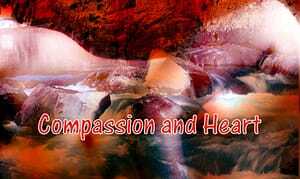
Compassion is a misunderstood word. Compassion is sometimes equated with “feeling sorry for,” and is often used as a bludgeon… “If you had an ounce of compassion, you’d look after me and do what I want.” And yet, in the Zen world, the compassionate act could be a kick in the ass. It’s often abrupt, and direct, and challenging.

Want to learn more about living a full and meaningful life?
Want to have the best relationship ever?
Check out my books
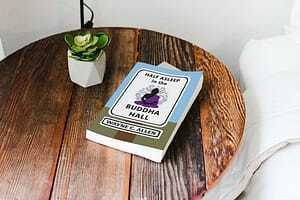
Looking for more on this topic? Check out my book, Half Asleep in the Buddha Hall.
Today, we turn to the Heart (4th) Chakra zone — the zone of CompassionPerhaps it goes without saying, but let me say it anyway.
This series, and pretty much everything else that I write, has to do with self responsibility. It’s scary out there!
It’s scary out there!Perhaps the greatest error that people make is to assume that their problems, solutions, passions, and disappointments are somehow connected to something “out there.”
We propose an alternative.Accept everything, and deny nothing.
Notice, I didn’t say “approve of” everything. We still live in a physical universe, and some stuff needs to be avoided.
On the other hand, I consider it the height of dumb to walk around like Mary Poppins, whistling happy tunes, and hoping that the big bad world will suddenly behave itself, preferably in Technicolor.
It’s an interesting walk, this.It is “very Zen” to talk about what is, and what is not real.
The short form is that the only thing that is “real” is the here and now, or the present moment.
Past and future are just stories we tell ourselves.
And the joke is, we don’t even have a self.
Brad Warner, wrote a book called “Sit Down and Shut Up,” which is a follow-up to his quite excellent “Hardcore Zen.”
Here are a couple of quotes.
“Self is just a mental construct, an idea, a way of understanding reality, a slot within our heads into which we place a certain portion of what we experience.”
Sit Down and Shut up, Page 21
Warner’s book is an exploration of the writings of an old Zen master named Dogen .“There is something, some segment of the vast and wide universe, that you carve out and call “self” and say belongs to “you.” It’s an odd idea, you know, that “you” belong to “you.” When you were very young, you noticed this aspect of the universe, and your parents and teachers and friends all told you in overt and subtle ways that this something was your unique “self.”…
ibid. pp25-26
You accepted this explanation and based your interpretation of all your experiences on this way of looking at things.
…Buddhists claim to have discovered that this ordinary and nearly universally accepted way of looking at things is absolutely untrue…
And they say that if we throw away this false view of things,absolutely every aspect of our lives will become immeasurably better.”
Dogen reminds us to always come back to “this concrete place.”
This concrete place is the present moment –
the only thing that is “real” and “for sure.”
Let me quote Warner again.
So, you may be wondering what any of this has to do with the heart.“Notice he says, “come back” — as if we had somehow left the concrete place where we are right now. How can we ever leave where we are? But we do it all the time. In fact, most of us are sunk so deeply into our own mental images that we can barely even recognize where we are anymore. We need to learn to come back to a place we have never left. It’s absurd. But that’s the way it is.”
ibid. Page 26
Well, there are two things to talk about. First, the heart area, on the chest side, is sort of like a layer cake. Many, many emotions lie dormant and unexpressed in this region. It’s not unusual, when pressing into this zone, to see sadness and grief, anger, then laughter emerge, one after the other.
If you shift to the upper back, specifically the back shoulder muscles (excluding the top of the muscle) and the muscles that lie to either side of the spine between the shoulder blades, you get all the responsibility stuff.
Or perhaps better put, the over-responsibility stuff.
Our language conveys the dual nature of each side of the body.On the chest side, we get comments like,
“Her heart wasn’t in it.”“It’s hard to trust enough to be openhearted.”“He was good hearted.”Of course, apparently, hearts swell, and are broken.And true feelings are heartfelt.On the back side, we
“Shoulder burdens”Get our backs up,are either spineless or “have spine.”– all expressions of willfulness, or the lack of it.
Because the heart has always been connected with love, (and boy, there’s a misunderstood word,) and because of the deluded belief that we love the other person (as opposed to our internal representation of the other person) we think that love is something we “do” to others.
In our view, love is simply one more way of being in the world.Love is actually a verb — an action — a way in which I choose to engage with the world.
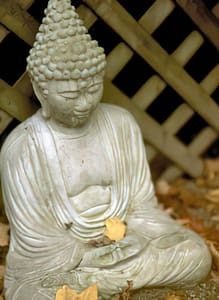 smiling
smilingHere’s another way of looking at it. I’m always trying to find a reference on Google to the facial expression that is commonly seen in paintings and on statues of the Buddha. I know I read this somewhere, but the Buddha’s smile is called, “The smile of infinite compassion.”
Now, compassion is yet another misunderstood word. Compassion is sometimes equated with “feeling sorry for,” and is often used as a bludgeon — “If you had an ounce of compassion, you’d look after me and do what I want.”
And yet, in the Zen world, the compassionate act could be a kick in the ass. It’s often abrupt, and direct, and challenging.Infinite compassion is recognizing that we are all the same — we are all caught in the same loop. We are all caught up in making up stories about our past, and fearing our future.
We are caught to the point where we think our imagined version of reality is not only true, but should be swallowed whole by our nearest and dearest.
Or, we equate compassion with rescuing, and exhaust ourselves trying to fix others. And then, we are shocked! shocked! to discover that the recipient of our bogus compassion is neither thrilled, nor changed, but certainly expects us to keep up the rescue. It’s all so nuts.
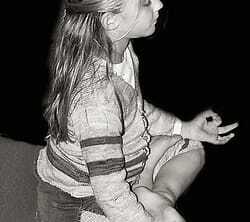 Just Do It!
Just Do It!I’m not going to do what I’ve been doing with this series of articles, and give you five or six suggestions of things you can do.
Rather, I’m just going to suggest, ever again, that you “hit the mat” and start meditating.
The ultimate compassionate act, the clearest and cleanest way to be in the world, is to “be” in the world — in this moment — fully and completely, is to learn to meditate.
From the cushion, you non-critically and nonjudgmentally watch your own mental gymnastics and games. You see your thoughts arise, like bubbles in soda water, insubstantial and meaningless, if you leave them alone. They arise, and they burst.
So what does this have to do with compassion, or “love?”Everything.
The only truly loving, compassionate act is to be present with another.
Not to fix, not to change, not to blame, not to manipulate. To be with. To “sit with.”
In other words, to be deeply and intimately present with whatever is going on. Without judgment, categorizationand without the need to “do.”
A loving act is an action, but it’s the simplest action of all. Let me quote Brad Warner again.
You could say that love and compassion are encapsulated in sitting with, and paying attention to, both ourselves and our present reality.“Zazen, in spite of its apparent lack of activity in the usual sense, is the purest form of action. It’s action reduced to its barest essentials, the action of simply sitting there and paying attention.… or you could say it’s the balance between thought and feeling. When these two opposing sides are perfectly equal, they cancel each other out, thus causing both body — the material side — and mind — the spiritual side — to appear to drop away.”
ibid. page 45
One of the ways Darbella and I do this is through what we think of as engaged dialog.
I speak about what I am doing to myself, the stories I am telling myself, the dramas I am creating, and the emotions I am manifesting. None of what I am doing inside of me has anything to do with her, or the situation. My job is to report what I’m doing.Her job, in that moment, is to “simply” sit and listen, without judgment and without attempting to fix anything. Any fixing required would be my responsibility, and only my responsibility, because I’m making the mess I’m sitting in.Then, we trade. Darbella talks, and I sit and listen — and strain to resist rushing in with solutions — given who I am, and what I do for a living, this is one of my greatest challenges.The love and compassion part is the willingness to sit and be present. Again, I say, without judgment. It is what it is.If your heart’s been hurt, that would be all about you and how you chose to see the situation. Most people hate to hear this. So much easier to blame others, so much easier to shut down, so much easier to curl over and be protected from the cold, cruel world. Except thinking and being this way does nothing more than shut you off from experiencing life.
Once you realize and fully accept that no one can hurt your heart (except for you of course!) it’s just plain silly to have it slammed shut, just in case. All that gets you is physical pain, and the deep and disappointing disconnection from your life and from others.
Be compassionate with your heart. Spend some time silently sitting, being present with yourself, breathing into your heart, and just listening. I have a funny feeling you may be surprised at what you learn.
Facebook TwitterAugust 22, 2022
Self Awareness — The Body Speaks
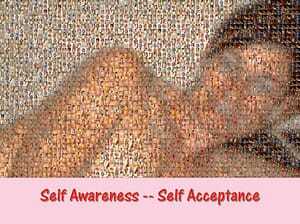
Self Awareness / Self Acceptance is all about studying yourself without taking yourself too seriously. It’s not “esteeming yourself,” but simply noticing that you are… who you are.

Want to learn more about living a full and meaningful life?
Want to have the best relationship ever?
Check out my books

Looking for more on this topic? Check out my book, Half Asleep in the Buddha Hall.
Let’s have a look at the zone of self awareness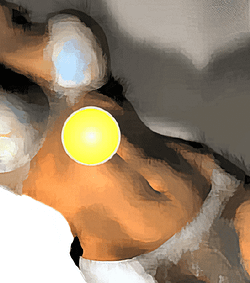 self awareness zone
self awareness zoneThe 3rd Chakra is located at the solar plexus. Its zone runs from the belly button to the solar plexus, and on the back from an inch or so above the pelvis to the mid back.
The major organ contained in this zone is the stomach.In this zone, it’s the stomach that most often gives us trouble.
For example, if you have to make a speech, and you’re not comfortable doing that, all of a sudden, you might notice that your stomach is queasy.
It’s not that you’re afraid of the audience—it’s not about something external. What’s going on here is that we are not comfortable in our own skins. In this case, we think that the audience is going to see right through us.
However, as usual, what happens for us is not about them. It’s about us.In the book, “Anatomy of the Spirit,” Carolyn Myss describes this zone as the zone of self-esteem.
I’ve been thinking about that, and while I “get” the whole self esteem idea, this is one of those terms that can be badly misunderstood. Being the Zen guy that I am, I’d much rather head down the path of self awareness and self acceptance — that’s what this article is going to be about.
The problem with self-esteemNorth Americans tend to equate self-esteem with pride, positive thinking, and eliminating everything that could be considered “bad.”
It’s almost as if people think that the goal of life is to repress the “bad list” while magnifying the “good list.” It’s like that song lyric,
“You’ve gotta accentuate the positive,
Eliminate the negative,
Latch on to the affirmative,
Don’t mess with Mister In-Between.”
Problem is, no one has ever pulled off this trick, and it’s a surefire recipe for misery. You see,
Mr. In-Between is actually right on track, at least from a Zen perspective.The problem with all this positive thinking nonsense is that it simply doesn’t work. Here’s how it goes:
you might get a moment’s peace, and start to believe that all that straining to be good is a great idea.And then life happens, and whatever normally goes on for you in reaction pops right back to the foreground.Then you flip to condemning yourself, blaming yourself, making life hard to stomach.Ben Wong and Jock McKeen wrote that the ego (the home of self-esteem) has only two functions. The first is to say, “Try harder and you’ll be perfect.” Then, when you fail, (because perfection is impossible,) the ego says, “You are such an idiot. But if only you’d try harder, you could be perfect.” It’s an endless loop, and a no-win situation.
Carl Jung was an amazing psychotherapist, and was able to see the magic and mystery of life. He, I believe, was the first to coin the idea of The Shadow side of ourselves, which is like the “bag we drag.”
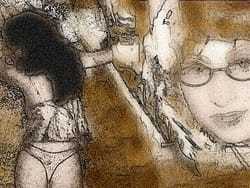 What’s hidden in the
What’s hidden in the “bag you drag???”
He said something like this: around the time we get to be six months old, we end up with this little, tiny bag — it’s sort of the bag that society provides us with, so that we have a place to “stuff all the stuff” society tells us is unacceptable.
Parents endlessly modify the behavior of their children—and do so verbally and nonverbally.
When you’re a kid, you don’t have much choice here– parents are bigger and pretty much have their own way of making you behave. So, whole aspects of your personality, your skill set, and your emotional set gets stuffed into the bag.
Over the years, the bag gets bigger and bigger. By the time we head off to work, or go to university, the bag may be 20 or 30 feet long. We’re dragging it, and don’t know it.
All we know is that something doesn’t feel quite right, and it feels like the weight of the world is on our shoulders.
Thus, the 60s question, “What’s your bag, man?” Is actually a pretty good question.Self acceptance, on the other hand, is all about the recognition that we are whole — the stuff in the bag is is much “us” as the stuff we show to the world.
I’m not suggesting that all the stuff in the bag is worthwhile — some of it should never see the light of day. It’s just that the bag that holds our stuff is sort of like any bag full of stuff.
We don’t have x‑ray vision, so the only way to know what’s in the bag is to empty it. Then, we can examine the stuff that we’ve stuffed, and make intelligent, adult decisions about what to keep and what to put back in the bag.
And here’s the kicker: the stuff we stuff back in the bag, having been evaluated in the light of day and by an adult, is still us!Self acceptance means precisely what it says. I don’t get to cherry pick who I am. If I run around, pretending that life is sweetness and light, and that I’m the sugarplum fairy, I am definitely going to trip over over the stuff I’ve stuffed, and fall flat on my face. It’s just the way it is, and we hate it, because our sensitive little illusions are getting all bruised.
The stuff we stuff has a way of oozing out.We want to deny it, claim someone made us do it, or otherwise escape responsibility, but as I said, the kicker is that the ooze is us, and we just haven’t accepted it.
Self acceptance matches the Buddha’s Middle Path.One of the most important insights in Zen is that we have the choice to deal with our stuff, and with all of life, without judgment.
This doesn’t mean excusing bad behavior. It means that, when we engage in something that gets us lousy results, we see it, accept responsibility for doing it, fix what we can, and move on.

It’s sort of like sailing a sailboat into the wind. If you watch a sailboat sail, you realize it doesn’t progress along a straight line. If tacks. Heads off in a direction, makes a course correction, heads off in another direction, makes a course correction… on and on, forever.
We don’t judge that the boat is bad because of the back-and-forthness of its path.
Self acceptance works only when paired with a total self responsibility.Back to the boat analogy. It would be the height of dumb to blame the wind for knocking the boat off course. Sailboats, like airplanes, are off course 95% of the time. Ultimately, tiny course corrections get them to safe harbor (or the airport…)
So there’s no blame involved, there’s just a simple acceptance that the way it is, is the way it is.
Judgment is never necessary.
Course correction is always necessary.
What a perfect definition of self responsibility
and self acceptance.
1. Make a list
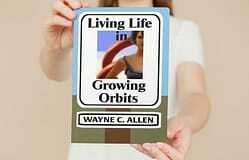
You might be interested to know that my semi famous book “Living Life in Growing Orbits” is all about this work. The very first exercise in the book, which you can read about on the website, is to list what I call Rock Beliefs.
You write down what you believe to be so about how the world works, and about who you are.
Most of our beliefs about the world and about ourselves are in the form of couplets. This is good, that is bad. Happy is good, angry is bad. Controlled is good, emotional is bad. We just naturally assume that the things we believe are accurate.
Then, we get angry, and because we know anger is bad, we look around for someone or something to blame for our anger. As opposed to saying, “I am angering myself right now.”
The reason this happens is that we are conscious of our good list, and only semi-conscious of our bad list. Here’s a hint. The stuff you’ve stuffed is the stuff that seems to just pop up, out of your control, the stuff that you desperately want to deny has anything to do with you.
Make a list of this stuff. Visualize your bag, draped over your shoulder, set it down, open it up, and start to figure out what’s inside.
2. What do you want?
I have a really sweet, dear friend, who has an odd little statement on her Facebook page. It says,
“In order to know who you are,
you must know who you are not.”
I disagree. Making lists of what we do not want, or listing who we are not is a totally meaningless and endless task.
It’s like being asked, “What you want for Valentine’s Day?” and saying, “I don’t want chocolate.” (Man, what a bad example! Everyone wants chocolate!)
The problem with this approach is the person asking still has no clue what you do want.
In order to know who you are, you have to identify yourself: this is who I am, and this is what I want.
Make another list. This list contains all the things you want, all of your desires, all of those hot and chargy things you’ve always wanted to do. As you list them, you may notice your judgmental, egoic voice whispering or screaming, “Don’t go there!”
Have a breath, continue to make your list, and then prioritize the list. Then, and you knew this was coming, start doing things on the list.
3. Have your emotions
Emotions are important — all of them! But what will likely pop into your head is the good list / bad list concept. Some emotions are good, many of them are bad and never to be expressed.
Think about expressing anger. Most people stuff their anger. People are sick, people are sore, people are sad, and much of it has to do with repressed anger.
List time again. Go ahead, just this once. Make two columns, and title I Good Emotions, and the other Bad Emotions.
Go for it. Make your lists. Now, put a circle around the emotions you know you have, but seldom, or never express.
Construct a plan to begin having your emotions. While this might be difficult, let me remind you that “have your emotions” does not mean judge, then suppress your emotions. Have means have.
4. Belly rub time
 Life, and belly rubs,
Life, and belly rubs, are a circle…
Here’s the Bodywork part.
The belly area is full of trapped emotions. It’s also filled with your guts, ironically. You can’t be gutsy if you block yourself.
Now, this is not particularly an easy area to work with, because you can’t just push on it. So, for now, consider getting someone to simply make circles on your belly.
Have the person rub massage oil on your belly from below your ribs down to your navel. Then, have the person press downward, comfortably for you, and circle your belly in a clockwise direction. Or pick a spot in the middle of the upper belly, and then circle outward in a spiral, in a clockwise direction, until I reach the circle I defined above.
5. Push your limits
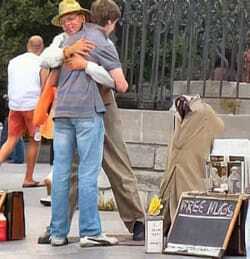 Don’t ask, won’t get.
Don’t ask, won’t get.Every time.
Back to the list that you made in the second point. I suggested you start implementing some things on that list. Now, let’s push it a bit.
Most people imagine dire things as a result of asking for something. In fact, most people refuse to ask for anything they really want, or if they do ask they do it indirectly. “Boy, it would be really nice to get a massage someday.” Indirect.
This indirection, or not asking happens for two reasons.Many people have horrible, imaginary outcomes tripping around in their heads — they ask, and are totally rejected. Or, and this is actually the less common problem,they have asked in the past and were rejected.Doesn’t matter. The time has come to explore who you are, what you want, and how you are going to live out your life, moment by moment, from this moment on.
Self responsibility means asking. If all you are hearing is “no,” you are definitely asking the wrong people. Maybe it’s time to hang around with a whole new crowd.
As I think about my relationship with Darbella, I recognize that “yes” happens about 95% of the time — perhaps higher. Why, oh why would I want to be in relationship with someone who only said “no?”
If this describes your relationship to your nearest and dearest, time to drop them off at the “Used People Lot.”
Then, look around. Find someone, or several someones, and ask for something that you’ve always wanted but have been afraid to ask for. Make this a day by day project for the rest of your life.
6. Be honest
I’m responsible for me! How exciting!
Self acceptance requires self responsible speech.
The only authentic pronoun is “I.” “I am making myself sad,” is true. The only one making you anything is you.
From this point on, own your emotions, your wants, your needs, your passions. Use “I” language with everyone you speak to. No blaming, no accusing, no looking to make trouble.
Be honest about who you are, what turns your crank, and what’s going on for you.
Facebook TwitterAugust 15, 2022
Passion for Life — The Body Speaks
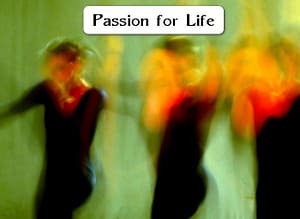
Passion for Life—The Body Speaks — we are built in such a way that we ought to see our life’s work—our vocation—as both sacred, and something to be passionate about.

Want to learn more about living a full and meaningful life?
Want to have the best relationship ever?
Check out my books
In the last article, we began to look at the zone of the body connected to passion. I mentioned that the area encompasses the lower belly and the lower back.
This “relationships area” rests upon the firm foundation of the First Chakra—the groundedness chakra.What’s really important to “get” is the idea that personal, emotional, and relational development requires that you “transcend and include.” In other words, in order to move on, one needs to have mastered each level.
Once you are grounded you have the stability to engage in meaningful and stable relationships.In this article, we look at passion for life.
Metaphorically, passion for life is located at the lower back—from the waist down, excluding the sciatic nerve pockets (they are a part of the Groundedness region.).
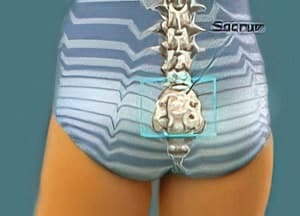
Contained within this region is the sacrum, the triangle-shaped bone that is just above the tailbone. It is not for nothing that the word sacrum derives from the same root as the English word sacred.
We might take from this that we are built in such a way that we ought to see our life’s work—our vocation—as both sacred, and something to be passionate about.
It is to this sense of sacred passion that we turn our attention.As with everything we write about, it is important to remember that our goal is balance. In this case, balancing is between our understanding and our feelings. Rather than ignore or suppress our feelings, we look to find meaning in what arises.
Here’s a weird thought for you.
In the case of the back pelvic region, the balanced state is full bore passion for life.
Given how emotionally, physically, mentally, and spiritually “dead” most people are,
this seems almost impossible.
Our societies, through socialization, attempt to “normalize us.” It’s even more insidious than that. When you think about it, people who are compliant, docile, and calm—to the point of boring—are also the easiest to manage–and are therefor prized by societies seeking control.
Most people are familiar with Thoreau’s famous quote,
“The mass of men lead lives of quiet desperation. What is called resignation is confirmed desperation.”
Passion scares “society,” and passion scares us. We think of those who have been considered creative geniuses, and part of us thinks that their genius hovered on the edge of madness—think van Gogh, Gauguin, Picasso.
Mostly, when confronted with passion, we’d like to see it dialed back.What I’m suggesting, and what I’ve seen in Bodywork, is that our passion for life, or perhaps better put, the thermostat for our passion for life, is set way too low. We think “semi-numb” is normal.
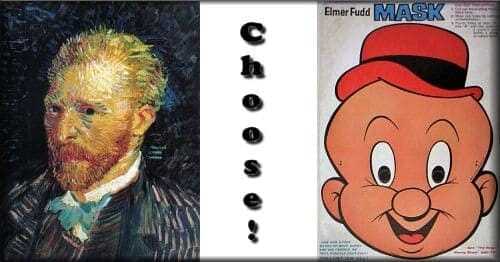
I wonder what the world would look like if “normal”
was closer to van Gogh than Elmer Fudd.
The first, and perhaps the most obvious is the left and right sides of the body—the left side is Yin, the right side is Yang.
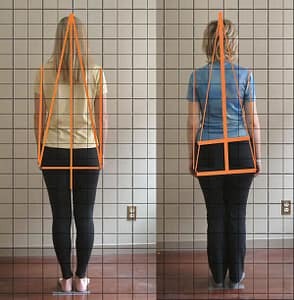
As regards our topic, passion for life, level hips (as we look at the pelvic region from the back) indicate the perfect balance between Yin intuition and Yang effort.
So, passion for life requires both
an internal, intuitive, emotional YIN component, anda practical, thoughtful, rational YANG component.Let’s turn to passionate living, vocation, and sacredness.Passion for life means living your vocation.
Most of us are aware that, at some point in our lives, we had one or more “burning desires.” We remember being “pulled” to excel at something.
Now, if the “thing” we were pulled to was “socially / tribally acceptable,” all was well and good. But in most cases, our yearnings and “burnings” didn’t fit, so our tribes forced us to repress them. Our passions and desires were something our parents / tribes teased us about—and if that didn’t discourage us from stepping out of the norm, some gentle or not so gentle form of repression was applied.
Parents have dreams and aspirations for their kids, and those dreams and aspirations are framed by the lifestyle and culture of the parents.Most parents freak out when they see the kinds of things that their kids are passionate about—that “turn them on.” So they do what they can to force the kid to fit in. They suggest that the thing that they’re passionate about is just a passing interest, or a hobby. Or they declare it off-limits altogether.
Kids don’t know any better, and actually listen to their parents, so they learn to tighten down and block their passion. From a Bodywork perspective, this involves freezing the pelvis, and tightening the muscles that are just above the pelvis.
The key to overcoming blocked passion for life is twofold: physical, and mental.The physical side, the Yang aspect, is about loosening the back pelvis through movement, exercise, and Bodywork. The physical side also requires actually doing something with your passion—as with an artist, you have to “put brush to canvas.”
The mental side , the Yin aspect, requires spending time reflecting / meditating. Your “passion-o-meter” is likely set pretty low, and you might have even forgotten what used to turn you on. You’re going to need some time to look inside, and to remember.
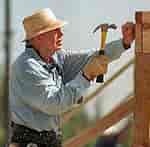 Building… passionately.
Building… passionately.I’m not sure why, but Jimmy Carter keeps popping into my head.
He took a bit of time out to be the president or the USofA, but really, two of his passions are bringing peace, and serving others. Which is sort of the same thing.
If you watch him now, decades and decades years after leaving the presidency, you will see that he’s pretty much on call when it comes to serving his passion.
He’s often out there, swinging a hammer for Habitat for Humanity. And he’s still the “go to guy” for brokering Middle Eastern peace. Despite being retired, if you get the joke.
Here are a few things to try:1. Bodywork
Naturally. The lower back can be worked on somewhat aggressively, and it’s all about finding tight spots. The key is to apply pressure, on the back, to the top of the pelvis. You’ll likely find sore spots that will yield to pressure.
You can also grip and squeeze the big muscles to either side of the spine, just above where the spine meets the pelvis.
As the tightness relaxes, you’ll feel warmth and the sense of a flow of energy moving up your spine. In Bodywork, getting this energy to flow is paramount.
2. Find a Jesuit!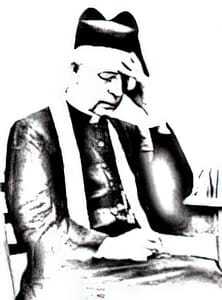 Not you again!!
Not you again!!Sort it out!!!
That’s a bit of a joke, but only a bit. The key is to track down someone who can help you explore vocation. Thus, my tongue-in-cheek Jesuit suggestion.
However…
When I was writing my masters thesis, I used to “dig in” by spending a week at a time at a nearby Jesuit Seminary. I wanted the privacy, the solitude, and the quiet to do some serious writing.
But, hey, it was a Jesuit Seminary — and that means there were, wait for it… Jesuits! Everywhere!
And despite a lot of bad press, most Jesuits are pretty smart.They are used to talking about vocation. They have tools for exploring vocation. One of their vocations is helping people to find their vocations, if you will. Now, of course, their principal direction, in the past, was to find more Jesuits. These days, they spend increasing amount of times with the laity, helping them to explore their vocation — their passion for life.
Failing finding a Jesuit underfoot, you might choke back your incredulity and hire a life coach — but please talk to someone and find someone qualified. I’m big on qualifications, and a six-month online course may just not cut it.
3. Breathe from Your Belly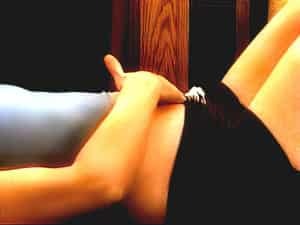
Sure! You want me to practice breathing! Right!
Your Second Chakra (the Lower Dan Tian in Chinese medicine) is located 2 inches below your navel. You want to work at bringing your breath to this place.
The easiest way to learn to do this is to place your hand over the spot, and then breathe deeply, into your belly. The breath should be deep enough to raise, or move, your hand.
Once you have a sense of what that feels like, imagine that your breath is bringing energy to this point. You can play around with the “how.” Imagine the breath coming moving down from your lungs or imagine energy coming up from the ground. Doesn’t matter, so long as the energy ends up, on the in-breath, flooding the Second Chakra region.
On the out-breath, imagine directing the energy. For example,
Imagine, on the out-breath, sending the energy from your Second Chakra to your hands.If you are doing something creative, imagine the energy moving up your spine and flooding your creative centre.If you’re with someone who needs support, breathe to your Second Chakra, and then imagine the energy, on the out-breath, flowing up your spine to your heart. From there, imagine the energy flowing into the palms of your hands—in Chinese medicine this point is considered an “out point” for heart energy. And once it’s there, the easiest way to “pass it on” is to give the other person a hug.Dance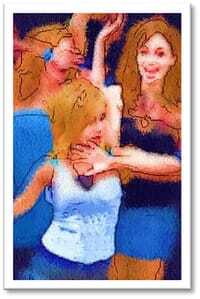
The Second Chakra Region moves in three ways.
it turns in a circle—think the Hula. it rocks side to side—think salsa dancing. it tips up and down—use your imagination!There’s music that is suitable for each of these three things.
The key one is the third one. This motion is so important that we teach it as a part of breathwork—you learn to breathe and then you learn to add a pelvic tilt. So, spend some time moving your pelvis as you dance.
This is a bit of a snapshot of the “passion for life” part of the second chakra region.Think about creating a masterpiece with everything you do. Continually imagine the fire of passion flowing up your spine. Visualize the sacredness of your life, relax your lower back, and also spend some time moving your pelvis.
I suspect you might be surprised by what emerges.
Facebook TwitterAugust 8, 2022
Centering — The Body Speaks
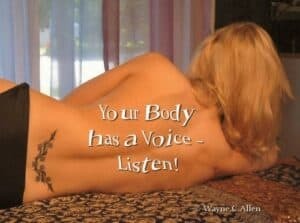
The Body Speaks — A New Series about all the things our bodies are trying to tell us. We’ll look at the ways to listen, and what to do next.

Want to learn more about living a full and meaningful life?
Want to have the best relationship ever?
Check out my books
It’s all about RelatingDarbella and I were having a conversation about relationships and passion for life with friends yesterday, and I was intrigued as we talked, as much of what is in this article got covered as we talked.
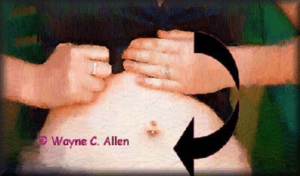 Lower Dan Tian,
Lower Dan Tian, a.k.a. the Second Chakra
This morning, an image popped into my head: of the Lower Dan Tian— in Chinese medicine this spot 2 inches below the navel — it’s also the 2nd Chakra area. I thought, “This spot is so central, so “core” to us, and this region is so “ignored.”
There are three important aspects to this region:
1) Relating,
2) Passion for Life,
3) Sexual Passion (and sacred sexuality.)

The entire region (the lower belly around to the lower back) is broadly defined as the “Relationships Region,” and that’s where we’ll begin.
This article will look at relating.
I want to spend some time persuading you that relating is “all about totally owning your perspective on things.” In other words, we’ll explore your relationship with how you “do” relating.
The region has a distinct front / back component.
The front pelvis and lower belly is about sexuality and sexual passion /energy, and
the lower back, from the waist down, is about passion for life.
This front / back pair will be covered separately in the next two articles. The same rule applies—we’ll look at how you relate to your sexuality and how you relate to your passion for life.
Relating With Others—The Dance of RelatingDevelopmentally, one of the first thing a baby “does” is ground herself. In the context of human development, the first “eye opener” is realizing you are outside of mom, and that now, you need externals (food, shelter, etc…) to survive.
Once this realization of “baseline existence” is internalized, relationship-building begins. This starts a few months after birth, because initially, babies are quasi-autistic and still enmeshed with mom.
Building relationship (an activity, so better put: relating) means that the infant begins the project of “me / not me,” which is the basis of survival, differentiation, and starting the next step: the development of a self / ego.
Initially, Relating = SocializationAs the infant begins the differentiation (me / not me) process, she discovers the expectations of others. (Remember, it took her a couple of months to realize that there actually are others.)
The first learning is this:
in order to get what I want, I have to do what the “big people” want me to do. Thus, relationship seems to be about “behaving” and being rewarded.
For example, “Susie” may cry. In rushes mommy with a breast or bottle. If Susie fusses while feeding, mommy may become cross, take the food away, or emotionally “cut off” her child, so Susie learns to be “happy-acting”—her needs are more easily met if she does what mommy wants.
Infants and children have nothing to compare their learnings to. So Susie is not sucking away and thinking, “Boy, is my mommy neurotic. Look at what a girl has to do to get her tummy filled!” No, she’s learning to “relate” by looking outside to see how “mommy” is, modifying her behaviour to make mommy happy, and learning that the only way to get fully fed is to manipulate others and the situation.
We call this inner/outer confusion.Sadly, most adults will read the above and think that’s how one relates. You ask, demand, cajole others into giving you what you want, as opposed to being self-actuated and self-responsible.
Next, the kid tosses in the “Kreskin” (mind reading) part. “Mommy” was pretty good at meeting your unspoken needs (you squawked a bit and a bottle or boob appeared… like magic), so you may still think that if someone loves you, they “ought to” be able to read your mind. Or, that you “ought to” be able to state your need or desire one time, and get your way from that point on.
Let me unpack. Inner / outer confusion is this:
I think about or want something, and I expect the external world to provide it. “I’m not happy, and you should change things or yourself, so I can be happy.“
Or, “Can’t you see how hard I am trying to make you happy, so that you’ll “feed me” what I want?”
Dysfunctional relationships are caused by clinging to infantile ways of relating. Every time I see a couple playing this “externals caused what I feel / externals should be different” game, I see three-year-olds fighting in a sandbox.
Stability comes from authentic relatingWhat I want you to understand is that the stability we are talking about could also be described as acceptance. Simply put: “I accept that the way I am, is the way I am, right now. If I want a different experience, I accept the responsibility for creating it…through the way I choose to relate with others.”
Vibrant Relating comes from Self-acceptance and Self responsibilityFrom a Buddhist perspective, the unsatisfactoriness of life is due to clinging—and what we cling to is an attitude, belief or object. We want more, more, more of what we like, and less, less, less of what we don’t.
We spend our entire existence wishing for what isn’t—
wishing that we could control the flow of our experience
by demanding that things (and others) become, and then stay, forever,
the way we want them to be.
Mark Epstein, has a book called “Going to Pieces Without Falling Apart.” Let me toss out a quote.
“But once we start to appreciate how it is the holding on to pleasure and the pushing away of pain that is the problem (not pleasure and pain themselves), we start to see how it is possible to practice in the midst of our daily lives.”
Page 141
And let’s face it, the attraction / repulsion we feel for our passion, for people we want intimacy with, and for our sexuality is perfectly described in this quote. Instead of acceptance, we engage in an endless dance of grasping onto and pushing away.
Relating is an actionSo, how do we get into trouble? We get into trouble by confusing how we relate (an action) with having a “relationship” (a static thing.)
Example: Mark and Sally come in for therapy and to want to talk about “the relationship.”
I would look at them while putting a quizzical look on my face. I’d say, “Relationship? I don’t see a relationship. I do see Mark and Sally engaging, or relating with each other. We can’t talk about your relationship as if it’s separate from how each of you relates to the other.”
Thus, relating is about how you enact your life; how you relate to what is around you.What is your behavior, how do you relate, to your nearest and dearest?
The useful approach is to let go of clinging to labels, having judgements, and demanding that others change so that you can be happy. You own your experience, your feelings, and your actions. You see each thought and action as it is—a moment and a behavior in the here and now.
Here are some ways to enact this as you relate:Express Your Stuff–Don’t Stuff it “Listen, sonny, the next
“Listen, sonny, the next time you’re angry,
shove it in here!”
It all starts with expressing your feelings and emotions. Fully.
When you were a tyke, you squawked and in rushed the big people, and made it all better.
As time went by, mom and dad trained you not to be annoying by getting you to shut up. They taught you to justify (and you seldom could) and then stuff your emotions.
Since childhood, your emotions have been internalized. They feel like pain and pressure, and you still want someone to rush in and rescue you from them, preferably without you having to say a word.
Grow up and get over it.
Your emotions are real, are yours, and are self-created. They need to be owned, (“I am angering myself”) and safely expressed.
Use “I” Language—All The Time!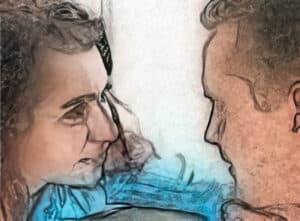
“Of course I’m being responsible! I’m responsible for pointing out how it’s all your fault!”
The bane of successful relating is the pronoun “you”—with or without the finger-pointing. Many are the justifications: “Normally I’d use “I language,” but this time you really went too far, and you’re ruining my … my… tranquility! Change! Now!”
The only use of “you” is for reporting an observation—
“I notice you got home at 7pm four times this week.”
Then, it’s all “I language”—
“I notice that I am concerning myself, and I am making myself angry, because I am choosing to feel isolated and alone. Here is what I would like to do differently…”
All you can ever report on is your internal experience of what you think is happening. It’s not true, it’s not real. My favourite way of stating this is to preface my comments with, “So, the story I am telling myself…”
You must adopt “I” language, all the time, no matter what, no matter how hard-done-by you are making yourself feel.
Ask For What You WantHint: You are not a prince(ess) being served by a court of lackeys. No one has a clue what you need this time. Stop setting people up for failure.
Many are the dramas that come from “If you loved me, you would know what I want,” or, “I’ve told you in the past not to give me advice.”
I’ve certainly been guilty of rushing in with advice for Darbella, and for a year or two she would preface every story with, “I want to tell you about a stressful situation, and all I want you to do is to listen.”
Of course, I had the option of discounting what she wanted, and I could have charged in with advice. But I live by the premise that I am not in relationship with Dar to fix her. I’m here to learn about her, and to tell her about me. Period. She’s an adult, and highly competent, and quite capable of fixing her own stuff. What she wants, what I want, is someone to vent with, someone to “simply listen.”
If you think you’re not getting what you want as you relate, ask yourself, do you ask? Drop the magical thinking, prince(ess), and start.
Be willing to hear “no,” and expect mostly to hear “yes,” and you’ll begin to get what you want.
Work on Each Other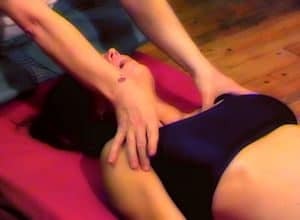
Find a Bodyworker, or take a Haven course, and learn to breathe together, and learn to do effective Bodywork on each other.
I find that, when I simply pay attention to Darbella, I can “see” her holding patterns. We’ve made a “deal” with each other. When we see a holding pattern, we have automatic and universal permission to reach out and apply Bodywork pressure, while saying “Breathe! Let it out!”
We do this with each other, all the time. It’s often noisy, teary, and filled with emotion. And then, it’s over, and life shifts. The emotion is released, and we have danced together. We don’t even have to discuss “what just happened,” because it’s just “stuff that was unstuffed.” No justification, excuses or explanations required.
Endlessly Let Go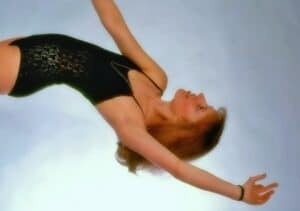
Most people in our culture tend to hold on to their “crap.” Past hurts (stories they tell themselves, not real…) past disappointments, all kinds of imaginary dramas, all are tenaciously clung to.
And many people in our culture are constipated—the medical version of holding onto the festering stuff that is better “dumped.” (Noticing the language???)
What do you hold on to? How much crap, old, old stuff, do you harbour, cling to?
Let it all go. I know. Hard. Until you do it. Then you see, and experience, freedom.
Facebook Twitter


